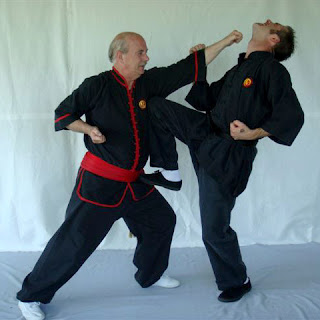by Phillip Starr
In a old thread on a martial arts forum, an instructor who is a close friend of mine presented a quote from Master Chosin Chibana, wherein he emphasized that (traditional) karate training is directed towards developing the ability to kill in a single blow. This was a very apt quote and one with which both the karate teacher and I (as well as many senior Yiliquan practitioners) agree whole-heartedly. Although I've done two or three lectures on this concept I'd like to toss out one more, which has to do with the mindset of this concept which seems to have been tossed by the wayside in most of today's modern martial arts schools.
Actually, the Okinawan and Japanese schools have always emphasized this more heavily than the Chinese. Insofar as kung-fu is concerned, the implementation of this concept and type of rigorous training varied from one system to the next. In some forms of Shao-lin boxing, the idea of killing in one strike was heavily emphasized, but in other styles such as Wing Chun and others, it is not (the idea is to land a "hit" and eventually beat the poop out of the other guy). My primary kung-fu teacher stressed the importance of developing this kind of skill and intent, and, of course, my early karate teachers pushed the same thing.
The idea of, and training for, killing an opponent with a single blow is one of the main things that separates traditional Asian percussive martial arts from their more modernized counterparts (many of which have become "sportified") as well as from numerous martial disciplines from other parts of the world. European fencing, for example, is not necessarily directed towards this end. Traditional Japanese kenjutsu is. Filipino arnis is not directed mainly to kill the enemy in a single strike, either...nor is western boxing, French savate, Russian systema (as nearly as I can determine considering my limited exposure to it), or South American caperoira. Karate (the original version) is. *Note: Grappling arts such as judo, sambo, jujutsu, and others are not percussive martial disciplines and do not really enter into this part of the article.
This is why the past Okinawan karate teachers were so selective about their students (the same is true of numerous Chinese styles) and why they were so insistent that training be approached with the utmost seriousness. Students were, after all, training so as to be able to kill another human being in one blow; of literally turning their bodies into living, breathing weapons which were capable of penetrating through light armor and ending the life of the person inside. In one strike.
The Japanese sword is not designed for lengthy sword fights such as one might witness in a European-style duel. The styles of Japanese swordsmanship did not provide training for such drawn-out affairs; the idea was to end the fight with a single cut. This is what their sword is made to do...to kill a man in a single blow (most swords are not capable of withstanding that kind of powerful shock). If you failed, you died. End of conflict.
I have seen dozens and dozens of teachers and styles both of karate and kung-fu which say, "If the enemy attacks like this, I can do this and this and this...." and so on. The oldsters would have simply shifted and dropped the bad guy where he stood. No fancy "twisting like a dragon" movements. Just shift, BANG!, and it was over. However, this kind of approach to fighting is foreign to us (Westerners). I suppose it has to do with our being accustomed to boxing matches and "fair fights" (whatever that is) and perhaps our sense of "morality" which shrinks from the thought of killing another human being. In the ancient Orient, such "morality" would get you dead very quickly. The old saying, "He who hesitates is lost" was never more apt.
In a sense, the old-time martial arts practitioners were akin to the gunfighters of the old American West. He wouldn't hesitate for an instant to blow you away and anyone who hesitated for even a microsecond because the thought of killing another human being was distasteful (or whatever) would end up with a new bodily orifice and a bed of pine wood. An old friend of mine from my law enforcement days who was a special agent for the FBI told me, "Never draw your weapon unless you intend to use it. And when you shoot, shoot to kill." It was a line I'd heard many times before but somehow, it meant more to me hearing it from him.
If someone makes a "small attack"; one that is not overly-dangerous, it can be handled with simple self-defense techniques. But if the situation is more severe, remember his words. "Never draw your weapon (karate/kung-fu) unless you intend to use it. And when you shoot (strike), shoot to kill."
Many, perhaps even most, of our contemporary versions of alleged "martial arts" are not directed towards this end; towards downing the enemy in an instant. We have "submission" wrestling (I still can't figure out how "submission" works in a street fight, especially when your life is on the line), "reality" fighting (I guess the traditional martial arts represent the "fantasy" forms...huh) - most of which has had very limited or no testing in reality...go figure, "natural" forms of fighting ("a baby moves his arm like this, so it's natural...and this is how you should strike, because it's natural")...except I've never seen an infant win a street fight...and God knows how many other variations on the theme. I think that when you get down to it, most people simply don't want to put out the effort required to develop the high levels of skill which are demanded in the traditional martial arts.
Whatever.
I know how I'm going to continue to practice. How about you?


.jpg)





.jpg)
.jpg)





.jpg)










.jpg)











.jpg)
.jpg)

.jpg)









.jpg)
.jpg)








.jpg)













